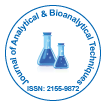Implementation of Liquid Chromatographic Analysis in Food
Received: 25-Sep-2021 / Accepted Date: 10-Sep-2021 / Published Date: 17-Sep-2021 DOI: 10.4172/2155-9872.1000001
Description
Liquid chromatography has become a useful tool in food analysis to ascertain food quality to implement regulatory enforcement or to comply with national and international food standards. Liquid chromatography is chosen for multiple applications because it can be applied to a wide range of different samples, allows separation of compounds ranging from ions to biopolymers and emplos mild separation conditions such as vitamins or polyphenols. LC also provides good sensitivity, resolution and selectivity.
Liquid chromatography is used in food analysis for measuring major food components such as carbohydrates, proteins and lipids but also minor components such as vitamins, articial additives mycotoxins, aminoacids, peptides, pigments, carotenoids and polyphenols, among others. Some of these applications. Even considering the broad range of applications observed for liquid chromatography other analytical techniques such as gas chromatography and capillary electrophoresis occupy an important niche in the compositional analysis of food for instance gas chromatography is the technique of choice or aroms and other volatile compounds and for these type of compounds provides higher effeiciencies and faster separations. On the other hand capillary electrophoresis is especially important when working with compounds bearing ionic charges in solution, since its separation principle is based on their relative migration in an electric field.
Foods are complex matrices and frequently the components of interest are present in small amounts compared to macro nutrients such as proteins, carbohydrates or lipids. These compounds when present in large amounts can interfere with the determination of minor components. There are several ways to overcome this problem in
liquid chromatography. Among sample preparation techniques prior to liquid chromatography solid phase extraction has been widely used to remove interferences from the food matrix and to concentrate the analytes of interest and it is based on the selective retention of compounds on a sorbent housed in a disposable extraction minicolumn. To cover a wide range of polarities several sorbents of polar, non-polar ionic and polymeric materials can be used.
Carbohydrates are one of the most important components of food and can be roughly classified depending on their molecular weight as sugars which might be composed of any units of monosaccharide’s. Carbohydrates are the main source of energy for almost all physiological functions including brain functions. In addition, carbohydrates exert other important effects being extremely important for blood glucose level, insulin metabolism and serum cholesterol as well as for colonic micro flora and gastrointestinal processes such as laxation and fermentation. Carbohydrates are synthesized by all green plants and in the body are either metabolized immediately or stored in the form of glycogen. Given the concerns about the use of toxic organic solvents in food chemistry many new techniques have been developed to overcome or minimize this problem. Environmentally clean extraction techniques such as those based on the use of compressed fluids, are widely usedas alternatives to conventional procedures such as solid-liquid extraction, liquid-liquid extraction and so on.
The alternative procedures have common ly used lower amounts of solvents, the lack of toxic residues higher the efficiency extraction and the improved selectivity of the process. It has been used in the food analysis as sample preparation techniques mainly for lipophilic compounds.
Citation: Nish V (2021) Implementation of Liquid Chromatographic Analysis in Food. J Anal Bioanal Tech 12: 002. DOI: 10.4172/2155-9872.1000001
Copyright: © 2021 Nish V. This is an open-access article distributed under the terms of the Creative Commons Attribution License, which permits unrestricted use, distribution, and reproduction in any medium, provided the original author and source are credited.
Select your language of interest to view the total content in your interested language
Share This Article
Open Access Journals
Article Tools
Article Usage
- Total views: 1315
- [From(publication date): 0-2021 - Dec 06, 2025]
- Breakdown by view type
- HTML page views: 687
- PDF downloads: 628
